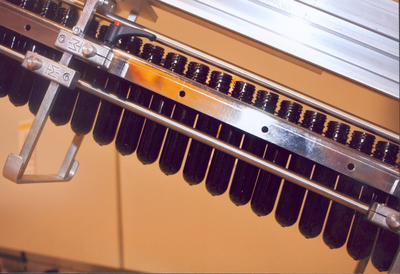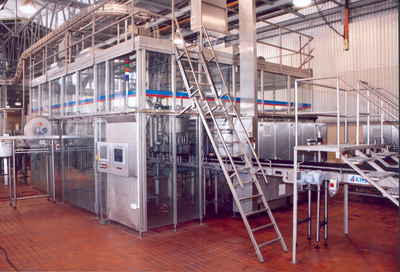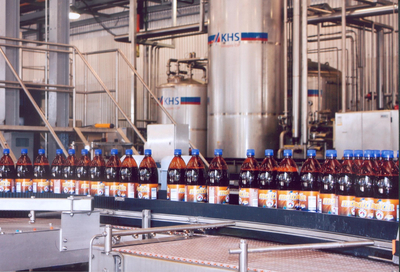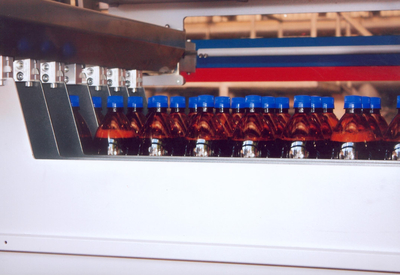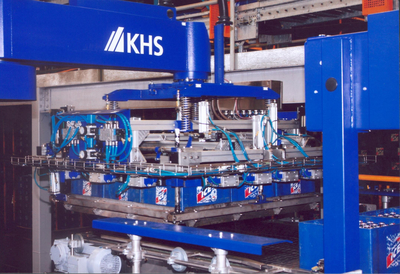
75 Percent Market Share for Beer, 90 Percent Market Share for Malt Beverages
Cervecería Polar, the biggest brewery group in Venezuela, invests in KHS turnkey line for Maltin
Ulrich Fischer*
Arepas and beer are two staples no typical Venezuelan household should be without! Breakfast without arepas in Venezuela, for example, is practically inconceivable. Arepas are small rounds of bread made from cornmeal that are usually eaten with cheese or sausage. Partying without beer here is also unthinkable, which means that Venezuela has a high per capita consumption of beer – at 90 liters a year by far the highest in Latin America. Whether as a supplier of the basic ingredient for arepas or as a manufacturer of beer, the non-alcoholic malt beverage Maltin, wine, soft drinks, mineral water, plus a number of other food products, such as pasta, rice, ketchup, mayonnaise, fish, ice cream and also animal foods and cleaning agents, in Venezuela there's one company that immediately springs to mind: Empresas Polar. The company is comprised of various divisions. Cervecería Polar, for example, is responsible for beer and wine, while Alimentos Polar is active in the food, animal food, and cleaning agent sectors. Pepsi-Cola Venezuela, part of the business in which PepsiCo International holds 30%, produces not only most of the products in the Pepsi portfolio but also several other alcohol-free beverages, including Minalba mineral water and Ad-Rush energy drink. Over 40 different operating sites employing over 30,000 people belong to Empresas Polar. About 200,000 Venezuelan employees profit indirectly from Empresas Polar – or roughly 1% of the entire population of Venezuela. As both a food manufacturer and brewery, Empresas Polar is the definite number one in Venezuela today. On an international scale, Cervecería Polar ranks 17 among the biggest brewery groups – but is in the top five in South America. The sweeping success of the company group is based on the fact that it maintains the highest standards of quality at all levels – naturally also with regard to the filing and packaging technology it uses for its beer, wine, and non-alcoholic beverages. It's thus hardly surprising that when recently investing in a new PET turnkey line for Maltin at the Los Cortijos site in Caracas, Cervecería Polar opted for plant engineering from KHS – as it did in the purchase of new glass bottle and can fillers and packaging and palletizing systems. Joaquin Tresselt, Technical Director of Cervecería Polar, says "KHS has been our trustworthy partner since the beginning of the 1970s. The fact that we are totally convinced by KHS engineering is demonstrated among other things by the 24 KHS filling systems we now have operating within our company group."
* Director, Latin America Business Area, KHS AG, Dortmund,
Phone: +49 (231) 569-1568
Four breweries with a capacity of twenty-six million hectoliters
Interestingly, Empresas Polar has its origins in a very different field from the one described. It all started with candles until Lorenzo Alejandro Mendoza Fleury hit upon the idea of opening a brewery in Caracas. No sooner said than done, and the brewery began its activities in 1941. To begin with, the brewery only made Pilsner beer. This didn't prove a big hit with the Venezuelan public, however. The big market breakthrough was sparked off by the idea of developing a light beer – this soon necessitated expansion of the brewery's capacity. In 1949, a brewery was set up in Barcelona in the east of Venezuela. In 1958, the existing brewery in Caracas was joined by a second and in 1961 a brand new brewery was erected in Maracaibo in the west of the country. Finally, in 1978, what was then the most modern brewery in Latin America went into production in San Joaquin in the heart of Venezuela. After concentrating its activities in Caracas on just one brewery, Cervecería Polar now has four breweries dotted about the country with a total annual capacity of 26 million hectoliters. Sales figures currently lie at around 23 million hectoliters per year. Beer accounts for 83% of this, with 17% ascribable to the non-alcoholic malt beverage Maltin.
Big hits in the range of beer products: Polar Ice and Polar Light light beers
Cervecería Polar has a market share of 75% on the Venezuelan beer market. In Venezuela, light beers are still in. The big hits in the Cervecería Polar product range are without a doubt Polar Ice (with an alcohol content of 4.5% by volume) and Polar Light (4% alcohol). Each brand accounts for around 42% of Polar's total beer sales, where Polar Light, the lighter of the two lights, is considered to be the brand with the greater growth potential. Next in line are Polar Pilsen and Solera Light, each of which has a 7% share of Polar's total beer sales, with Solera and the non-alcoholic Zero beer brand making up the remaining 2% of sales.
Beer: a fun, national beverage
With the brands of beer mentioned above, Cervecería Polar caters to all target groups. Polar Light is aimed at young adults of between 18 and 30, with Polar Ice the brand for 30 to 45-year-olds. Polar Pilsen, on the other hand, is destined for the 'establishment' of the over 40s. With higher prices, Solera Light and Solera have been earmarked as the beer brands for higher earners and special occasions. Tresselt says "Beer in Venezuela is considered a national beverage that is both tasty and fun. Over a cool glass of beer, the young and old, the rich and the poor can come together – an integrating factor."
The 222-milliliter glass bottle – beer bottle number one
It is more than understandable that in the tropical climate of Venezuela only really cold beer promises satisfaction. There is thus one bottle here that has proved more popular than all the others: the 222-milliliter size. About 80% of Polar's quality beers are now filled in this style of bottle – out of which the typical Venezuelan then drinks his beer, guaranteed to be nice and cool, without bothering with a glass. Other glass bottle sizes used at Cervecería Polar come in 330 and 355 millimeters.
Most of the glass bottles used by the brewery are refillable. Eighty-five percent of Polar's high-quality beers reach the consumer in returnable glass bottles, with just fifteen percent distributed equally between disposable glass bottles and cans.
Of increasing importance: non-refillable PET for Maltin
The situation is a little bit different with Maltin, Cervecería Polar's alcohol-free malt beverage. Here, 60% of all bottles are refillable, with 40% of them non-returnable. The reason for this is that as a non-alcoholic malt beverage Maltin is competing with a number of other soft drinks, 60% of which are sold in the disposable PET bottle. "The trend towards the non-refillable PET for soft drinks was, in the end, the main reason for investing in our new KHS PET turnkey line, specially chosen for the bottling of Maltin", says Tresselt.
Venezuela top world consumer of malt beverages
Not only beer consumption is high in Venezuela; a high percentage of malt beverages are also drunk. This figure is so high that at a per capita consumption of 15 liters per year, Venezuela comes second worldwide. The main target group for malt beverages is children and young adults. In an attempt to get even more young adults on board, with Maltin Cervecería Polar has produced a malt beverage that is very drinkable but not too sweet. The fact that this strategy is paying off can be measured in Maltin's success, with Cervecería Polar's soft drink alone capturing 90% of the Venezuelan malt beer market.
New KHS PET turnkey line for Maltin with plenty of flexibility included
With the new KHS PET line for Maltin, Cervecería Polar is meeting the growing demand of the population for malt beverages in PET bottles. At present, Maltin is currently being filled in 1.5-liter and 0.5-liter PET bottles. The definite focus is on the 1.5-liter PET bottle, which in Venezuela is the typical family-size bottle. KHS' innovative line equipment is designed to handle 22,000 0.5-liter disposable PET bottles per hour or 15,428 1.5-liter PET non-refillables per hour. Besides the sizes of PET mentioned above, the system can also process other types of PET bottle. "Flexibility for all future eventualities" is the motto at Cervecería Polar.
Inline manufacture of PET bottles
The non-returnable PET bottles are produced inline by an InnoPET Blomax stretch blow molder with 14 blow stations. The preforms are fed to the blow molder and heated in the machine oven according to a precisely specified heating profile. In the blow stations, the preforms are then stretched with mechanical precision and simultaneously inflated with compressed air. The finished PET bottles are turned and then directly transferred to the Innoline LTR air conveyor. It was important to Cervecería Polar that the blow molds could be changed within a minimum amount of time for product changeover. The InnoPET Blomax 14 has thus been equipped with the Speed-Loc quick-change system, guaranteeing that mold pairs and bases can be switched in a very short time, in turn promoting the high efficiency of the line.
Rinser-filler-capper monoblock in ultra-clean room
The finished PET bottles are conveyed gently and safely along a short air conveyor segment directly to the rinser-filler-capper monoblock. It is important that the sensitive malt beverage be bottled under the strictest hygienic conditions, making filling without the need for preservatives possible. The rinser-filler-capper monoblock has thus been placed in an ultra-clean room. A part of the ceiling is equipped with filter units, which directly filter the surrounding shop air. A slight amount of overpressure ensures a permanent flow of air from the ceiling to the floor. This provides the open PET bottle conveyors with a continuous supply of filtered air, specifically preventing the entry of unfiltered shop air. In order to prevent growth of bacteria, production is briefly interrupted approximately every two hours for automatic disinfection of the surfaces of the entire machine block and the inside walls of the glass housing. Tresselt notes "This system perfectly creates the utmost hygienic conditions for bottling Maltin."
Within the ultra-clean block, the rinsing process is handled by the electronically- controlled Innoclean FR-ZR two-channel rinser. After rinsing with disinfectant, the PET bottles are sprayed out with fresh water.
Filling system with plenty of advantages
The rinser is monoblocked with a computer-controlled, single-chamber Innofill DRV filling system equipped with 80 filling stations. Prior to filling, the malt beverage is gently pasteurized by the Innopro KZE flash pasteurizer. A special feature of the filling system is that it operates with only two pneumatically actuated membrane cylinders for the entire filling process. These membrane cylinders both lift the bottles and press and seal the bottle mouths against the filling valves. The pressure filling method used for carbonated malt beverages pressurizes the PET bottles with gas from the ring vessel. The force created by the pressurization pressure is transmitted by a membrane piston directly to the neck ring holder. This force alone lifts the bottle and presses the bottle mouth against the filling valve. No additional lifting elements are necessary.
The Innofill DRV also offers advantages provided by filling using a swirler including eliminating spreading elements protruding into the bottle in addition to maximum flexibility. This makes it possible to fill a very wide variety of PET bottle shapes and sizes without any need for reconfiguration. The following describes the filling process in brief. Once the filling valve is opened, the swirler forces the liquid over the bottle walls into the PET bottle at high speed. A reduced filling rate is used in the area of the narrower bottle neck. Pressure-regulated snifting and calming is carried out at a pressure of approximately 1 bar. Final snifting follows. The formation of excessive foam is specifically avoided.
CIP sanitizing is another special feature of the Innofill DRV. Here, the filling valves are sealed by what are known as CIP plates, which are automatically inserted into a groove in the bottle holder underneath the filling valve and automatically retracted when CIP sanitization is complete. The same method used for bottle pressing is also used for CIP sanitizing. The filling valves are automatically sealed by the pressure of the rinsing solution according to the interior pressure.
After the filling process is over, a capper integrated into the monoblock applies screw caps to the freshly filled PET bottles. The next stops in the line for the PET bottles are the pasteurizer and the roll-fed labeler.
Shrink packer for all conceivable shrink pack situations
After this, the PET bottles travel on to an Innopack Kisters SP 060 V shrink packer. The Innopack SP 060 V processes the incoming containers on one lane forming six-packs of 1.5-liter PET bottles and packs of 12 and 24 0.5-liter PET bottles. The shrink pack system is also flexible and has various other options that can be exploited as required. If additional types of PET bottle are to be processed, for example, the machine is adjusted accordingly by entering the relevant parameters into the system.
The Innopack SP 060 V operates as follows. The PET bottles, distributed into lanes by funnel-shaped guide rails according to the accumulation principle as they enter the machine, are first divided into specified product groups by a servo-controlled grouping unit. The respective product groups are then fed to a top flight bar chain to bring the formations in the machine pitch. The formed units are guided to the film cutting station where the film is fed via a vacuum conveying belt from the bottom part of the machine in the direction of the product formation. The film wrapping process is precisely adapted to the respective product heights and lengths of the packs to be wrapped. After they are wrapped in film, the packs are conveyed to the shrink tunnel by a speed compensation belt. In the shrink tunnel, the first step is to seal the overlapping sections of film underneath each pack. In a further step, adjustable air nozzles inflate the packs with hot air at controlled temperatures, thereby triggering the subsequent shrinking process. The temperatures in the shrink tunnel are adapted to both the quality of the film and the size of the pack.
Palletizing using column robots
An Innopal RS 3 palletizer is used to palletize the shrink packs. The Innopal RS 3 is a single-column palletizing robot for the medium and upper capacity range. Depending on the performance required, the machine can either be used as a single-station or two-station setup. By using various palletizing heads, the two-station machine is ideally suited for palletizing and depalletizing returnable containers, such as high-wall and low-wall plastic crates or kegs, and for the palletizing of disposable packs, such as shrink packs, trays, and cartons. In this case, the shrink packs are pushed onto the pallet by a roller cage head. Centering the last layer placed on the pallet on all four sides ensures safe and gentle palletizing when the roller carpet is removed. A pallet liner inserter has also been integrated into the palletizing concept. To secure the load further, finished pallets pass through a pallet wrapper and are then transported to the storage area by forklift truck.
Best product quality secures the future
To quote Tresselt again, "The important thing for us is the outstanding results we achieve with this new KHS turnkey line with regard to product quality – and the great flexibility of the line that makes us fit for the future. In our opinion, the KHS system concept has been thought out down to the very last detail. But then we didn't really expect anything else, as we have always traditionally placed great trust in KHS."
Cervecería Polar – a pioneer in the use of electronic KHS filling systems …
This trust has been substantiated on several occasions. Take KHS' electronically controlled filling systems, for example. Cervecería Polar was one of the first breweries in the world to take advantage of such filling systems from the word go. Tresselt claims "Right from the outset we have been extremely satisfied with mechanical KHS filling systems. To this very day we can see the clear advantages these systems have given us, particularly in the processing of various types of bottle or can on one line."
… restocks its electronically-controlled KHS filler range
It thus comes as no great surprise that Cervecería Polar has again recently augmented its extensive range of KHS fillers. One piece of new equipment is an electronically controlled, pneumatic Innofill DRS-ZMS pressure filling system that is virtually predestined for the low-oxygen filling of beer in glass bottles. It acts as a replacement investment for the now rather aged filling technology in operation in an existing line. Another new acquisition is an electronically-controlled Innofill DVD can filler that guarantees maximum filling accuracy through electromagnetic inductive flow metering and which has been installed in a new canning line together with the recently ordered Innopack Kisters TSP 060 V tray shrink packer.
A partnership that just goes on and on
Just recently, Cervecería Polar also ordered five more Innopal RS 3 palletizing robots to replace its existing palletizing technology. "We are in permanent contact with KHS", says Tresselt, "as we are always in need of new technical systems for our breweries that meet our high quality standards. KHS provides precisely the technology and systems we require for our planned success on the market. And that is worth a great deal."
Cervecería Polar – the brewery group from Venezuela for Venezuela
Tresselt envisages this success for Cervecería Polar above all, but not just in Venezuela. A small percentage of product is thus already being exported. The main exports are Polar Pilsen and Polar Ice, which chiefly go to Columbia, Panama, Florida, New Jersey, Aruba, Curacao, Trinidad, Surinam, Haiti, and the Dominican Republic. Within Venezuela, Cervecería Polar is present nationwide – which is to be expected with a market share of 75% of the Venezuelan beer market. Whether supermarket, kiosk, or restaurant/bar, there are about 200,000 points of sale that stock cool beer or Maltin made by Cervecería Polar. Consumers have learned and remembered Polar's blanket presence – which is good, seeing as the advertising of beer has recently been heavily curtailed in Venezuela.
Whether advertising for beer on TV, radio or posters, or just a simple ad for beer on the side of a truck – all of this is now no longer permitted in Venezuela. Luckily for Cervecería Polar, the polar bear has long been a symbol of freshness here – and every Venezuelan knows that the polar bear and quality beer or Maltin by Cervecería Polar form a symbiosis. According to Tresselt, "Even in this respect we are profiting from foresight and planning and even in this respect we are well prepared for the future." There is one very significant, perhaps the most significant factor that has helped prepare the company for the future: Empresas Polar has been family owned for decades. President Lorenzo Mendoza currently heads the company group in its third generation. He will continue with the company philosophy that includes a good portion of social commitment to its employees, their families, and the population of Venezuela as a whole. Empresas Polar is a company from Venezuela for Venezuela that draws strength and success from the fact. And so it shall remain.


